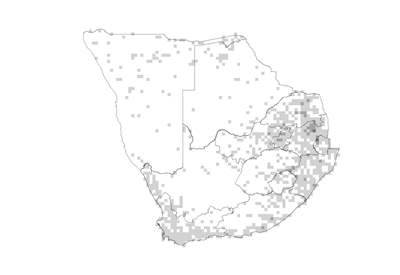 Species distribution and density. Darker squares represent higher density of members of this family. |
Introduction
Ink flower family
Members of the family often only occur sporadically but will always catch the eye. Flowers are brightly coloured and plants are usually seen as curiosities. They are frequently glandular and offer interesting photographic subjects. In some classifications many of the genera are included in the Scrophulariaceae but the relationships within the latter remain unresolved.
Distribution
A cosmopolitan family found in the temperate areas of the world. In southern Africa a number of species are widespread. The highest density is in the eastern part of the country, but they are also found in the Northern and Western Cape.
Number of genera in the world
90
Number of species in the world
2 000
Number of genera in the Flora of southern Africa region
15
Number of species in the Flora of southern Africa region
90
Growth forms
Annual or perennial herbs or shrubs, either holo- or hemiparasitic on the roots of plants.
Habitats
In deep or shallow sands, from coastal to inland dunes, in grassland and fynbos, often in rocky areas and on mountain slopes, also in cultivated lands.
Flagship species
Cycnium racemosum (large pink ink plant; berginkplant [A]; uhlaba-hlangane [Z]) is up to 0.8 m tall and has very large pink, scented flowers in a terminal raceme. Flowers turn black when bruised. Plants are used traditionally to treat pain and ease childbirth. Usually found in grassland on rocky outcrops.
Significance of the family
The parasitic plants are important due to the negative impact on production of cultivated crops such as beans and peas. Striga species can become quite a nuisance in crops and are difficult to eradicate. (Photo: HV).
Diagnostic characters
Parasitic plants ; turn black when damaged or pressed . Leaves petiolate, sessile or scale-like, alternate. Flowers irregular , with 2-5 sepals, lobes overlap or are just touching with middle lobe towards back ; ovary superior.
Did you know?
A holoparasite has no chlorophyll and cannot survive without a host, while a hemiparasite has leaves and often also an extensive root system to produce and absorb nutrients.